What could possibly say "Happy Valentine's Day" better than two cans of beer?
How about two cans of beer decorated with a ribbon and a rhinestone heart?
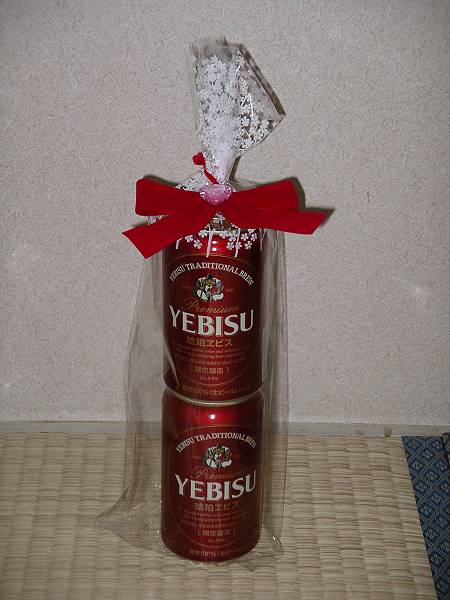
How about two cans of beer decorated with a ribbon and a rhinestone heart?

|
What could possibly say "Happy Valentine's Day" better than two cans of beer?
How about two cans of beer decorated with a ribbon and a rhinestone heart?  Yesterday was Setsubun, the day before the beginning of the "spring season" in Japan. Setsubun is a day akin to New Year's, when people engage in rituals to chase evil away from their homes and bring good fortune in during the year. The most famous ritual is mamemaki, or "bean throwing." Mamemaki involves the head of the household throwing beans out the door of the home at someone dressed as a demon, while the family members chant: "Oni wa soto! Fuku wa uchi!" ("Demons out! Good luck in!"). You're also supposed to eat one bean for each year of your life to bring good luck. Here in Kitakami, stores were selling peanuts to be used for mamemaki, rather than soybeans.
We didn't do mamemaki at home (scaring demons away is why we have big fuzzy dogs), but we did partake in the ritual of eating ehomaki at Hige-oyaji's place. This tradition allegedly originated in the Kansai region, but has spread to other areas of Japan. Ehomaki is a fat sushi roll (called futomaki on non-Setsubun days). If you can eat the entire uncut roll while praying, and without speaking, it is believed that you will have good fortune throughout the year. You eat the ehomaki while facing the eho (direction of good fortune) for the year. The eho is determined by the year of the Chinese zodiac; this year, for the year of the mouse, the direction was south-southeast. Hige-oyaji had a fancy Setsubun compass, set with zodiac symbols and their related directions, to tell us what direction to face. Unfortunately, I didn't completely understand what was going on, so I ate most of my ehomaki facing a wrong direction. Oops. On Sunday, we went bowling as part of a group event. Bowling in Japan is no different from bowling in the States, down to the clownish rental shoes.
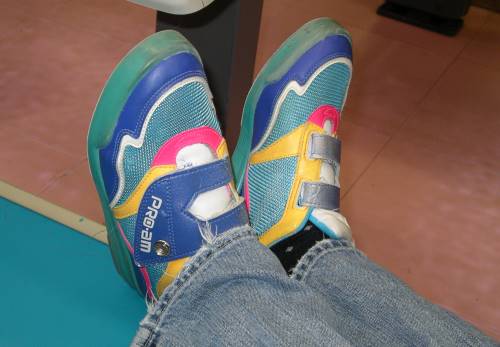 We haven't gone bowling in a very long time, so it took us a few frames to get back into it. Our team actually did pretty well ― three of us broke 100 on the first game, and we all did on the second. The event was a fundraiser for the local sign language club, some of whom we've met through local friends. In between turns, they were teaching us little bits of Japanese Sign Language, including the signs for "Washington" and "America." As it turns out, the frowny face accompanying a blown spare is an international sign. At the end of the tournament, the group gave prizes to each participant, ranked from highest score to lowest; I think we were all in the top twenty. Also, people who threw gutter balls had the dubious distinction of getting extra prizes based on the number of gutters thrown. Matthew got one: 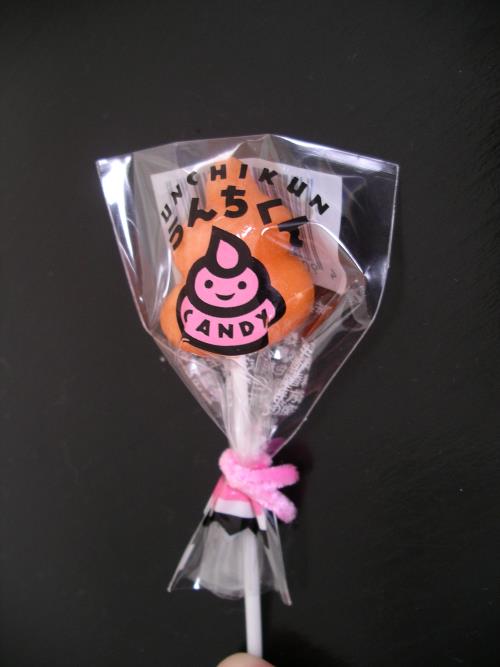 Yes, it's candy poop on a stick. A lollipoop, if you will. You can find almost anything your heart desires in vending machines in Japan: soda, beer, hot canned soup, 10-kilo bags of rice. . .
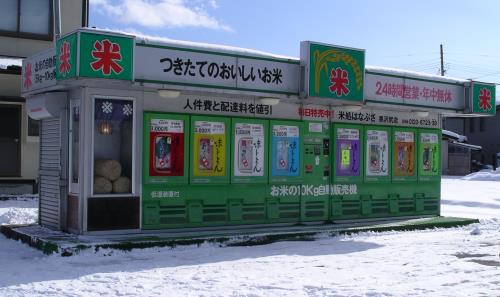 This machine has gotten some play before, courtesy of the late, great, Kitakami Photoblog (Konnichiwa, Julia-san!). Last weekend, I had to make dessert for a dinner party. Wanting to do something with fruit, I headed to the produce section, thinking about citrus or maybe pears. Those thoughts were blown out of my head by the sight of row upon row of . . . bright red strawberries. And a big sign proclaiming the arrival of the "Strawberry Fair."
In Japan, winter is the high season of the strawberry. Strawberries sit in little boxes in displays at the front of the store, announcing their provenance and price ("Fresh Strawberries from Sendai! 680 yen!"), drawing attention away from all the other fruits. Every patisserie sets out an array of strawberried treats ― filled, topped, stuffed with jam, you name it. Strawberry KitKats, strawberry danish, and strawberry eclairs are everywhere. Traditional sweets, like daifuku (anko-filled mochi balls) contain strawberries at this time of year, too. The prominence of strawberries in January is very strange to me because, as for most Americans, strawberries scream "summer!" It seems somehow wrong to see them everywhere when we're still rocking our snowboots every day. A bit of research revealed that in many parts of Japan, strawberries alternate with rice as a part-of-the-year crop, so it's not completely out of the question that they would be reaching peak over the winter months. In fact, the strawberries we've eaten were grown in Japan and were quite delicious. On the other hand, it makes me think: perhaps the strawberry producers are in cahoots with the weathermen ("If we sell strawberries during the winter, they'll make people think of summer! They'll forget that the temperature hasn't gotten above freezing in six days, and all will be right as rain!). Let's take a look at today's weather, shall we? Here's the weather report. It's pretty typical for winter in Tohoku: snow in the morning, and cloudy all day after that.
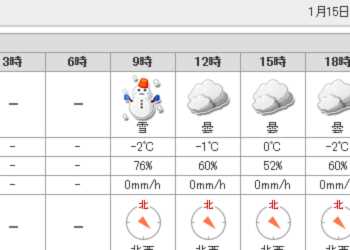 Now, let's take a look out the window: 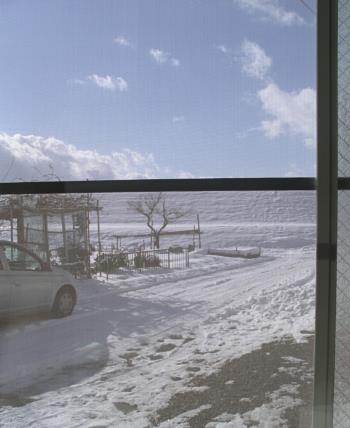 That's about how it goes with the weather forecasts here. They aren't just inaccurate, they're willfully dishonest, or at least it seems so. My theory is that the weathermen are part of a secret government program to emotionally control the people and prevent revolt. When it's nice out (or will be), the forecast shows nasty weather, so that everyone gets a pleasant surprise and is happy. When it's nasty out, the forecast shows nice weather tomorrow or the next day, which gives people hope (even though the nice weather doesn't actually arrive until three weeks later). Many people in Japan, male and female alike, hang multiple small mascots from their keitai (cell phones). Mascots range from characters associated with the phone company to well-known comic, manga, or anime characters. I've only got one on my cute pink phone.
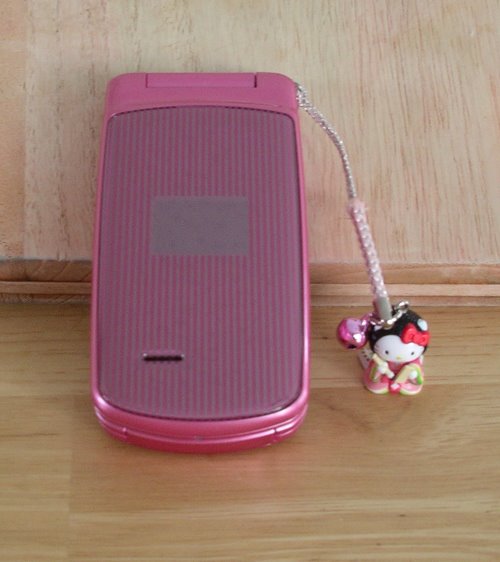 It's Hello Kitty, of course, but she's special. Sanrio makes Hello Kitty merchandise specific to each of the prefectures, representing events or products for which the prefecture is known. This Kitty-chan represents the famous Heian period poetess, Komachi, who according to legend was from what is now Akita Prefecture. Komachi was also regarded as a great beauty, which Matthew thinks makes her name particularly fitting for the Akita Shinkansen. 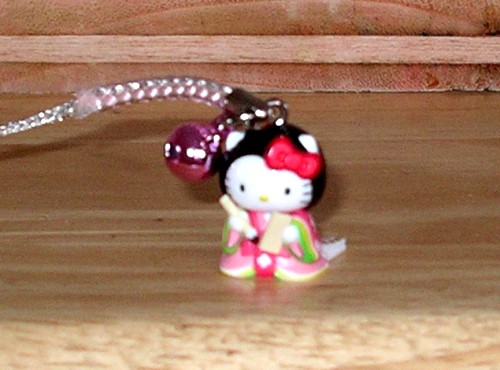 To make the most of our Japan experience, we've been choosing to participate in Japanese traditions, rituals, and events as much as possible. For New Year's Eve, that would have meant a quiet evening at home and a trip to the temple or shrine at or around midnight. Then a friend told us that there would be a more festive celebration at American World, one involving fireworks. Being Westerners, we like fireworks on New Year's. So, the three of us bundled up for the frigid night ahead and made our way to American World.
Much to our relief, events started indoors with a live variety show featuring impersonators of famous Japanese performers. There were also a number of cosplayers (people wearing full costumes of their favorite anime or manga characters). The show was totally fun, and probably would have been even better if we knew the personalities involved. On the other hand, how can you not love seeing a manic guy sing "Livin' La Vida Loca" in Japanese? At one point, an enka song began playing. We knew an impersonator would perform the traditional music, with its themes of love, loss, hardships, and loneliness. We did not, however, expect this: 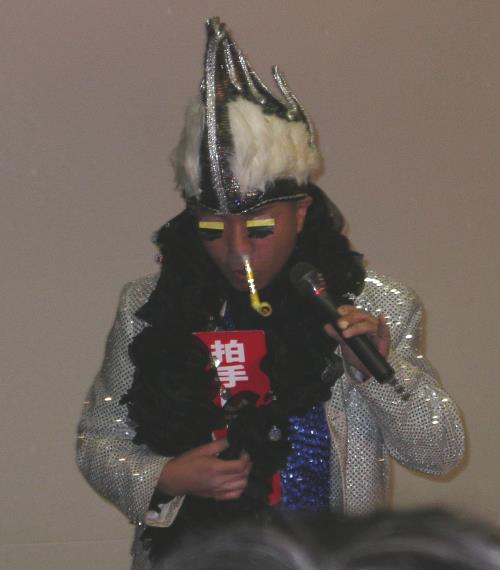 There were also a bunch of people running around in mouse costumes to celebrate the upcoming Year of the Rat/Mouse. It made Matthew feel like he was in a Monty Python sketch. After the show, we were herded outside into the cold, cold, Tohoku night to await the fireworks. About ten minutes into our half-hour wait, organizers started a bonfire in the parking lot ― ahh, blessed heat. I think the girls wearing short-shorts, knee-high socks, and parkas were also grateful for the bonfire. Somewhat inexplicably, there were also a few practice runs for the countdown (in Japanese) to the "Happy New Year" (in English) shout. It must have paid off, because both went off without a hitch. Yay, 2008! Also, yay, fireworks! They were very cool, and much more like an American fireworks display than the two-hour extravaganza for Michinoku Geinou Matsuri (which was good because, well, cold). Fireworks were followed by the organizers tossing balls of mochi into the crowd for good luck. We are not good at catching mochi. Once the events were over, we retired to the house with some local friends. Matthew made amazake, a warm, sweet fermented rice drink, and we ate black sesame and walnut mochi made by the neighbor across the street. Sitting with our feet under the kotatsu with friends new and old, and the dogs lounging nearby, was a perfect way to spend the early moments of the new year, traditional or not. Nengajou are traditional New Year's postcards in Japan. They are sent to arrive on or after New Year's Day. It's even considered rather awkward if they arrive early! Late is okay, but it's really best for them to arrive on January 1.
For this reason, the post office has a special system set up. When correctly marked as a nengajou, cards are set aside for special handling. Then on New Year's Day, they mobilize thousands of extra employees to deliver all the cards on the same morning. There's a long tradition of handmade cards. In the month before New Year's you can buy blank postcards, which you can decorate by hand with stickers and rubber stamps. You can also use a stencil machine, print them from your computer, or simply draw them by hand. Recently, there are also services in camera shops and on the internet to order your own custom designs. People without such creative inclinations can buy them with pre-printed designs. This year, instead of Christmas cards, we decided to send out nengajou. We used stickers and rubber stamps to decorate ours. A nice feature of making them by hand is that it's easy to make each one unique. 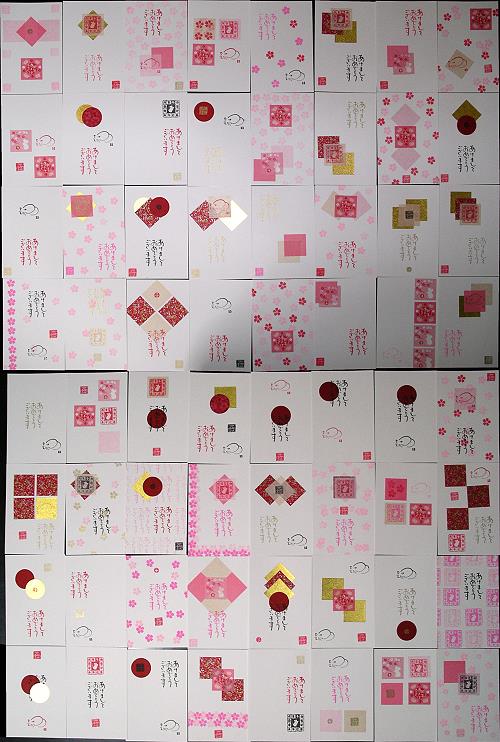 And here's a closeup of one card. 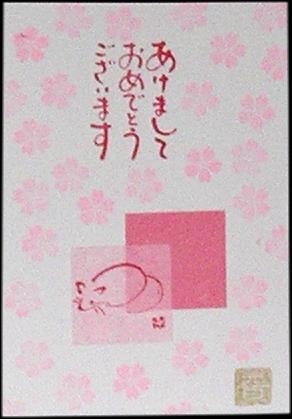 2008 is the "Year of the Rat" on the Asian calendar. There doesn't seem to really be much distinction between mice and rats here (the Japanese word for mouse is actually "small rat"), so it's really treated as the Year of the Mouse. That's why there are all the cute little mice on our nengajou. We've both been here long enough to have unusual experiences and eat unusual things. On the eating front, they've almost always been things we've chosen to eat ― nobody really springs freaky stuff on the unsuspecting gaijin. For example, one night at Hige-oyaji's place, he started showing us some more adventurous Japanese foods, including hizunamasu, a Hokkaido regional specialty. Hizunamasu is thin slices of pickled salmon head, cartilage and all. I rather liked it; it makes a nice accompaniment to a mug of beer. He also showed us his big jar of shiokara, which Wikipedia defines as "small pieces of the [sea] animal's meat in a brown viscous paste of the animal's heavily salted, fermented viscera." It's frequently served with shots of sake, perhaps to no one's surprise after that description. We'd gone there a number of times before that night, so we assumed that he'd only busted out the potentially yak-inducing fish preparations because he knew us well enough to know that we wouldn't gag or otherwise freak out.
So it was with little or no trepidation that we visited a new-to-us fish restaurant earlier this week. The owner/chef had a pretty standard set of dishes on his menu: nabe teishoku (hotpot served with rice, pickles, and another side of some type); grilled fish teishoku (same thing, but with grilled fish in place of the hotpot and with miso soup); fried fish, maybe an oyster stew. Matthew ordered the seafood nabe teishoku, I went with grilled fish. Things were proceeding as they usually do until we were served. Then the following conversation took place: MAD: I don't know how to eat a whole fish head. SKD: Oh, farm. Is that shiokara? Indeed, on our trays sat little bowls of shiokara, apparently a standard teishoku dish at this restaurant. We ate our other things, glancing at the ruddy brown dish every now and again. Finally, we each bit the bullet and tried it without the benefit of sake because we still had work to do. And. . . it wasn't half bad ― it was quite salty, and tasted rather like fishy miso with bits of squid in it. Mostly, it was a good reminder of what should be the motto for our lives here: expect the unexpected. Back Next |